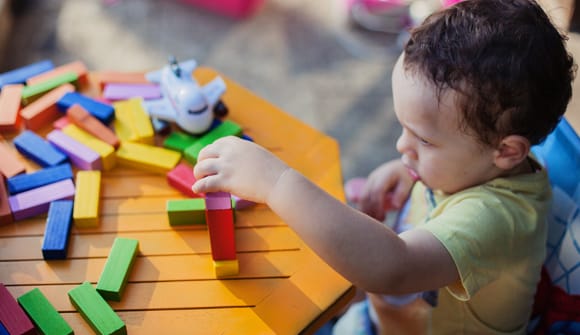When milestones aren't met
How to tell if your child needs speech, physical or occupational therapy.
Article Author: Katie McPherson
Article Date:

When your baby isn’t crawling or your child doesn’t seem to be picking up writing as easily as others, it’s normal to be concerned. A little Googling can lead you down a rabbit hole of confusing abbreviations: PT for this, OT for that, and what the heck are SLPs? If you think your child might need some help meeting milestones, here’s the breakdown of all things rehabilitation.
How will I know if my child needs rehabilitation services?
Suzanne Barje, PT, a pediatric physical therapist and system manager for Wolfson Children’s Rehabilitation, said when babies and kids aren’t meeting the usual developmental milestones, it may be time for physical, occupational or speech-language therapy.
Signs your child may need physical therapy (PT) include:
- Not rolling over when expected
- Not crawling when expected
- Not sitting up independently when expected
Occupational therapy (OT) might be helpful if your little one:
- Is not using his or her hands for things like eating or holding toys
- Has trouble writing, doing puzzles, or similar activities
Speech-language therapy (SLP) may benefit your child if he or she:
- Has difficulty latching onto the bottle or nipple to feed
- Is a picky eater (older children)
- Is not making noise or babbling
What are the differences between physical, occupational and speech-language therapies?
When you think about adults, occupational therapy usually has to do with completing tasks of daily life — learning to walk again after major surgery, or how to safely put on shoes when age begins to affect your balance. But what about with children? How is OT different from PT anyway?
“Occupational therapy focuses on what we call fine motor skills, and predominantly works with the torso and upper extremities,” said Barje. That includes getting infants to use their hands to grasp toys and put food to their mouths, improving hand-eye coordination and more. “Physical therapy focuses on what we call gross motor skills, and predominantly works with the torso and lower extremities. This includes skills like sitting up, crawling, walking and more.”
Speech-language therapy involves all kinds of communication and eating skills. This is because speech-language pathologists (SLPs) specialize in the anatomy of the mouth and throat, which are in charge of both speaking and chowing down. SLPs can help with verbal and nonverbal communication skills, assist with infants’ latching or feeding after the child has feeding tubes, and even work with picky children who have texture issues with certain foods.
How can I get my child in to see a therapist?
“In order to see a Wolfson Children’s Rehab therapist, you need a referral from your child’s physician. That could be their pediatrician, family physician or another specialist,” said Barje. “Then you can schedule at any clinic closest to your home.”
And remember, all babies and children develop at different paces. By visiting your child’s pediatrician first, he or she can help determine if your child is truly behind on a milestone, or if your little one is just developing on his or her own timeline.
Your baby or child’s first rehab appointment will last around 90 minutes, and he or she will be evaluated by Wolfson Children’s Rehabilitation experts. Your child’s team will work collaboratively with you to determine your child’s needs, your family’s goals, and to set up a care plan.
“We treat the child as a whole,” said Barje. “While Wolfson Children’s Rehabilitation therapists specialize in their areas of expertise, they incorporate all of the aspects of the child’s goals from the other disciplines into the sessions to provide the most opportunities for success.”
What if my child needs something more?
Thanks to the new Wolfson Children’s Rehabilitation Intensive Therapy Center, located in Baptist HealthPlace at Nocatee, families can apply for a more intensive rehabilitation program (using some pretty cool, leading-edge technology). The center treats children with cerebral palsy, developmental delays, traumatic brain injury, spina bifida, and other neurological conditions, as well as those recovering from a stroke or rhizotomy surgery.
The center offers three programs:
- Therasuit®, which includes daily intensive OT and PT sessions for three weeks. During these sessions, the patient wears a soft canvas suit with bungee-like cords attached to an exercise cage for support. The pull from the cords mimics what the child should be feeling when he or she is moving during gross and fine motor patterns, retraining the brain so the child can move independently.
- Post-rhizotomy care, which includes daily intensive therapy for three weeks. Rhizotomy surgery cuts the sensory nerve rootlets that cause muscle spasticity. Once that tension is relieved, this program strengthens those muscle groups so the child can improve his or her mobility and function.
- Constraint-induced movement therapy (CIMT), which includes daily OT intensive sessions for 3 weeks. A cast or other constraint is placed on a child’s unaffected limb to encourage the use of the injured or weakened one instead.
“At the ITC, we work on both gross and fine motor skills,” Barje said. “We work on being able to sit, crawl, take independent steps, stand, use an affected hand more functionally, get dressed, improve hand-eye coordination, and more. We also have speech therapy in this clinic, so patients might have intensive therapy in the morning, a little bit of a break, and then speech therapy later on.”
If your child is having difficulty with any physical, occupational, speech or feeding tasks, call 904.202.4200 to learn more about Wolfson Children’s Rehabilitation. For more information about the Wolfson Children's Rehabilitation Intensive Therapy Center, call 904.271.7500. Pediatric therapists offer treatment for developmental delays, fine or gross motor challenges, acute or chronic medical conditions and more.



